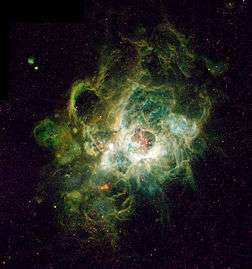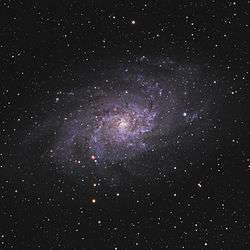NGC 604
NGC 604 is an H II region inside the Triangulum Galaxy. It was discovered by William Herschel on September 11, 1784. It is one of the largest H II regions in the Local Group of galaxies; at the galaxy's estimated distance of 2.7 million light-years its longest diameter is roughly 1500 light years (460 parsecs), over 40 times the size of the visible portion of the Orion Nebula. It is over 6300 times more luminous than the Orion Nebula, and if it were at the same distance it would outshine Venus. Like all emission nebulae, its gas is ionized by a cluster of massive stars at its center.[4] with 200 stars of spectral type O and WR, a mass of 105 solar masses, and an age of 3.5 million years;[2] however, unlike the Large Magellanic Cloud's Tarantula Nebula central cluster (R136), NGC 604's one is much less compact and more similar to a large stellar association, being considered the prototypical example of a Scaled OB Association (SOBA)[5]

NASA/ESA Hubble Space Telescope provides the sharpest view of NGC 604 so far obtained.
References
- Some data in the table was updated from Sue French's column "Deep-sky Wonders", in the January 2006 issue of Sky & Telescope, p. 83.
External links
 |
Wikimedia Commons has media related to NGC 604. |


 . Bibcode:2004AJ....128.1196M. doi:10.1086/422925.
. Bibcode:2004AJ....128.1196M. doi:10.1086/422925.